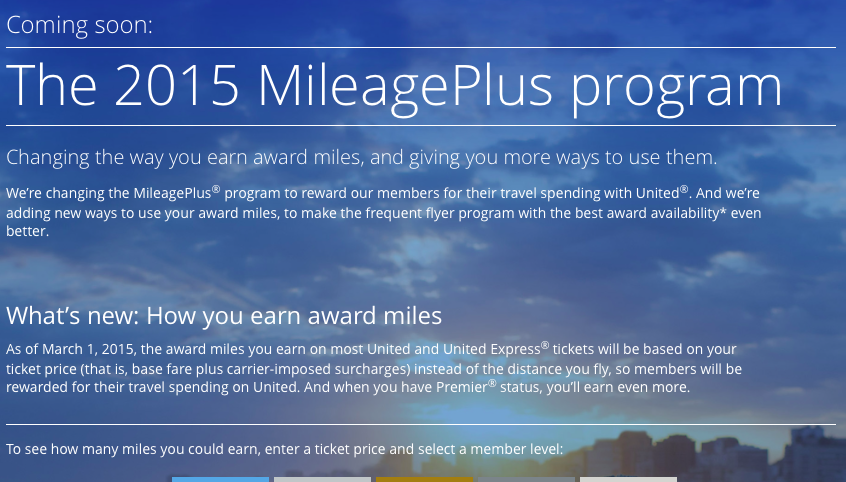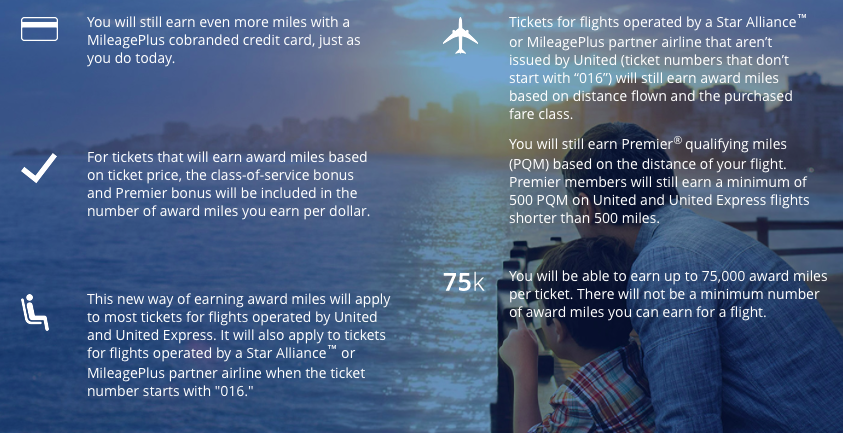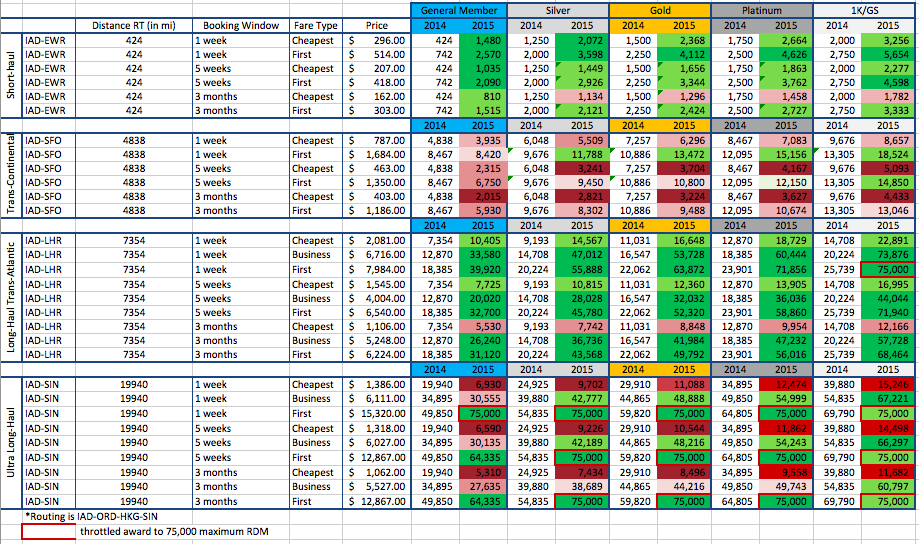Analysis: How Will United’s New 2015 Revenue-Based MileagePlus Program Impact You?

Yesterday, United Airlines announced the new MileagePlus earning structure for award miles that will go into effect on March 1, 2015. Basically, United is changing the way one earns miles from a system based on the mileage flown to a system based on the price of one’s ticket. Customers will no longer be able to rack up tons of miles by finding deals on long-distance trips. The only way one will be able to earn miles flying United is by the price of the ticket.
This change only affects the earning of Redeemable Miles (RDM) within the United program — these are the miles that one earns and then can redeem for free travel. This change does NOT change the way one accumulates Premier Qualifying Miles (PQM) — the miles that determine one’s status with the airline. United announced changes to that system last June, and they took effect on January 1. Those changes added a Premier Qualifying Dollar requirement in order to qualify someone for elite status.
The basics to Tuesday’s announcement are as follows according to United’s website:
As of March 1, 2015, the award miles you earn on most United and United Express tickets will be based on your ticket price (that is, base fare plus carrier-imposed surcharges) instead of the distance you fly, so members will be rewarded for their travel spending on United. And when you have Premier status, you’ll earl even more.
Earning Rates are below, as listed on the United site:
Some important caveats follow here from the United site:
This highlights a few important points:
- There are no longer RDM bonuses for class of travel and Premier status, as those bonuses are contained in the earning rates
- This system only pertains to United-ticketed flights. Flights ticketed and flown by partner carriers will still earn RDMs based on mileage flown.
- There is a cap of 75,000 miles earned on any flight
Are you confused yet?
The changes announced this week definitely have a profound affect for those frequent flyers who rack up miles and/or status on cheaper tickets. It essentially kills the value proposition in this opportunity.
I decided to perform an analysis on these changes to figure out:
- How this change affects different types of elite customers
- How this change affects different types of flights
- What is the break-even price of a ticket where the RDMs earned in 2015 equals that of 2014
- How this change affects general populations of customers
- How this change affect my travel profile
I knew that this change would be potentially catastrophic for me, but I wanted to run the numbers to see just how bad it really is. I decided to run an analysis based on four flights from my home base, Washington-Dulles. In order to account for different types of flights, I priced out the following round trips:
- A short-haul trip from Washington-Dulles (IAD) to Newark (EWR)
- A trans-continental flight from Washington-Dulles (IAD) to San Francisco (SFO)
- A long-haul, Trans-Atlantic flight from Washington-Dulles (IAD) to London-Heathrow (LHR)
- An ultra long-haul flight from Washington-Dulles (IAD) to Singapore (SIN) with a routing through Chicago-O’Hare (ORD) and Hong Kong (HKG)
I priced all of these flights on June 11, 2014 for the following booking scenarios:
- Last minute booking (~1 week): June 18-21 for IAD-EWR and IAD-SFO; June 18-25 for IAD-LHR and IAD-SIN
- Booking 5-weeks out: July 16-19 for IAD-EWR and IAD-SFO; Jun 16-23 for IAD-LHR and IAD-SIN
- Booking in advance (3 months): September 11-14 for IAD-EWR and IAD-SFO; September 11-18 for IAD-LHR and IAD-SIN
So what does this analysis tell us for…?
General Members:
- It’s a win for short-haul since not getting 500-mile minimums
- All-in-all a bad thing for Trans-Continental fares; especially the most discounted fares
- Not terrible for long-haul unless buying a cheap, economy ticket
- Terrible for ultra long-haul in economy; bad for business; great in full-fare First class
Premier Silver Members:
- All in all, it’s okay unless paying super cheap fares planned far in advance for short-haul
- Trans-continental travel is terrible unless buying last-minute, first class fares
- Transatlantic looking good unless buying cheap, economy fares
- Terrible for economy fares of all kinds on ultra long-haul. Business is a small improvement unless a “discount business” fare; first is massive increase
Premier Gold Members:
- Slight increase for everything except for cheap, economy tickets. Last minute F is an increase
- Trans-continental travel is terrible unless buying last-minute, first class fares
- Transatlantic looking good unless buying cheap, economy fares
- Terrible for economy fares of all kinds on ultra long-haul. Business is a small improvement unless a “discount business” fare; first is massive increase, but capped at 75K
Premier Platinum Members:
- Slight increase for everything except for cheap, economy tickets. Last minute F is an increase
- All-in-all a bad thing for Trans-Continental fares; especially the most discounted fares
- Not terrible for long-haul unless buying a cheap, economy ticket
- Terrible for economy fares of all kinds on ultra long-haul. Business is a small improvement unless a “discount business” fare; first is massive increase, but capped at 75K
Premier 1K/GS Members:
- Slight increase for everything except for cheap, economy tickets. Last minute F is an increase
- All-in-all a bad thing for Trans-Continental fares; especially the most discounted fares; start to realize some increases in first tickets
- Good thing for Trans-Atlantic flights, except for cheap economy tickets
- Terrible for economy fares of all kinds. Business is a small improvement unless a “discount business” fare; first is massive increase, but capped at 75K
What does this analysis tell us for different types of flights?
Short-Haul Flights
- For the most part, an increase in RDMs, with the exception of cheap economy fares for elites.
Trans-Continental Flights
- Major decrease in RDMs. The exception is for last-minute, expensive first class fares.
Trans-Atlantic Long-Haul Flights
- Increase in RDMs for everything except discount economy fares (>$1,300)
Ultra Long-Haul Flights
- Major decrease for any economy fares. Huge increase for first class fares and for more expensive business class fares.
- Notice that RDMs are capped at 75,000 RDM per round-trip. This caps off the potential earning for long-haul first class tickets, BUT even in some of the most drastic circumstances, one would still earn more RDMs in this new system for any round trip less than 21,429 miles (assuming that passenger is a 1K or GS, flying in Global First Class).
Break-even Ticket Prices
I continued to analyze for each of these scenarios exactly how much one would need to spend on a ticket in the 2015 MileagePlus Program to earn the same amount of miles as they would in the 2014 MileagePlus Program. I also added in several mileage milestones to use as guidelines to see how much one must spend on a ticket in 2015 to receive the same amount of RDMs as they would have in 2014.
How do these changes affect you?
- Occasional flyer who buys cheap tickets:
- It really doesn’t affect you that much. You will earn fewer RDMs on most cheap, economy fares, but it wouldn’t be in such a volume to cause you to avoid United.
- Frequent Flyer (Elite) who primarily flies Trans-continental flights:
- This devaluation hurts you unless you purchase relatively last-minute, first class tickets.
- Frequent flyer (Elite) who shops for cheap tickets and deals; Mileage Runners:
- It’s time to start looking at other programs. This is a significant devaluation from a RDM perspective, and there are better options out there (for now). United MileagePlus is no longer a good value for earning RDMs.
- Frequent flyer (Elite) who flies on expensivefares (last-minute or premium fares):
- This change is potentially extremely lucrative for you. Specifically, if you fly expensive short-haul tickets, or long-haul flights in premium cabins.
Essentially, the everyday leisure traveler does not gain much from this, and is actually hurt a little bit as far as mileage accrual, but not enough to where it should sway them from United. The big winner here is the corporate traveler whose company is most likely bankrolling their flights.
So, I suppose these changes aren’t all bad… unless you’re the one playing for the ticket.
What does this mean for me?
As an elite (United Premier 1K) customer who primarily flies cheap tickets – especially cheap trans-continental and long-haul fares, this devaluation is a game-changer and deal-killer for me. I will no longer be using United Airlines as my airline of choice unless they’re clearly the least expensive choice on a trip that I must take.
I plan to status-match or challenge with American Airlines, who has yet to change to a revenue-based system (for now). Once this challenge is complete, I may fly United to bank some RDM miles before this change on March 1, 2015.
In conclusion
This is a game-changer for me. Honestly, it’s a huge devaluation for the frequent-flyer / points community. However, all is not lost, as this change is not the End-of-the-World for the occasional leisure traveler. This new MileagePlus Program clearly benefits those that United deems to be their more valuable customers – those who spend top dollar on premium tickets and those who spend really high amounts on otherwise cheap tickets. I can see the potential benefit in this for United, even though it significantly alters my personal travel profile. It will be interesting to see if this alters United’s customer loyalty enough to influence their bottom line in one way or another.


